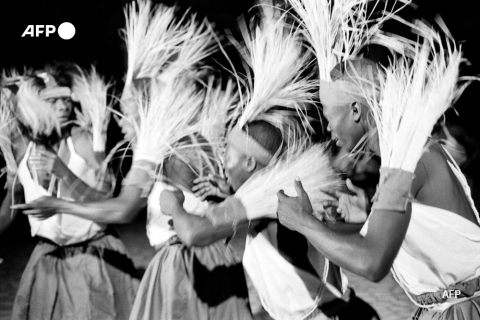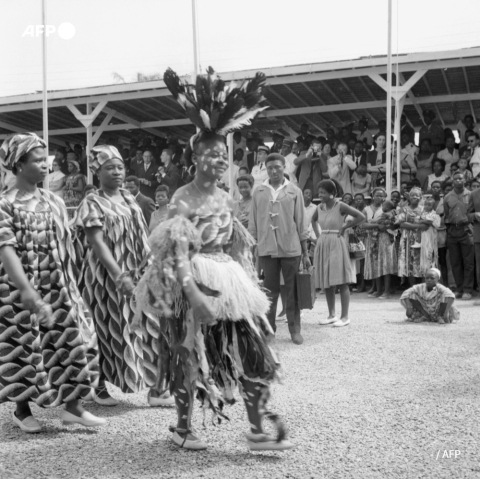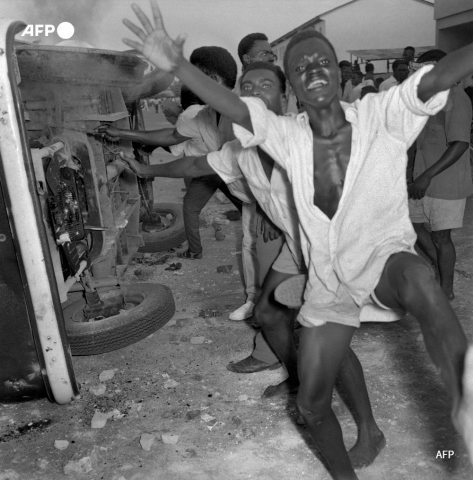A long road to independence

The decolonisation of sub-Saharan Africa gathered pace in the 1960s after the British and French territories of Ghana and Guinea led the way to independence. Portugal's colonies broke free only in the 1970s.
Here is a summary of how it happened.
- British colonies -
In 1957 Ghana became the first country in sub-Saharan Africa to win independence.
Britain negotiated others case by case. Nigeria and Somalia became independent in 1960. In 1961 it was the turn of Sierra Leone and then Tanganyika, which became Tanzania after merging with Zanzibar three years later.
Uganda followed in 1962; Malawi (formerly Nyasaland) and Zambia (formerly Northern Rhodesia) in 1964; and The Gambia in 1965.
Kenya declared independence in 1963 after a brutal crackdown on Mau Mau fighters who battled colonial rule from 1952 to 1960.
Botswana and Lesotho were independent in 1966; Swaziland and Mauritius in 1968; and the Seychelles in 1976.
In 1965 Rhodesia's white-minority government unilaterally proclaimed independence, which was not recognised by Britain or other countries. A guerrilla war achieved black-majority rule in 1980 and the country was renamed Zimbabwe.

- French colonies -
In 1958 General Charles de Gaulle called on France's colonies to choose between joining a Franco-African community or immediate independence. Only Guinea opted for self-rule.
Fourteen other colonies broke away in 1960: Cameroon in January followed by Senegal, Togo, Madagascar, Dahomey (Benin), Niger, Upper Volta (Burkina Faso), Ivory Coast, Chad, Central African Republic, Congo-Brazzaville, Gabon, Mali and then Mauritania in November.
The process was often difficult with independence movements facing a harsh ripost from French authorities, for example, in Madagascar where 10,000-100,000 were killed in a clampdown on an uprising that started in 1947, according to different sources.
The Comoros islands gained independence in 1975, except for Mayotte which decided to remain part of France. Djibouti followed in 1977.

- Belgian colonies -
Congo, today's Democratic Republic of Congo, was the personal property of Belgian King Leopold II for 23 years before becoming a Belgian colony.
It became independent in 1960, after riots in Leopoldville, which is today called Kinshasa. Two other Belgian colonies became independent in 1962 under the names of Rwanda and Burundi.
- Spanish colonies -
Five years after gaining autonomy, Equatorial Guinea became independent in 1968.
In 1975 Spain ceded Western Sahara to Morocco and Mauritania, despite opposition from Polisario Front separatists who declared the Sahrawi Arab Democratic Republic in 1976.
Three years later Mauritania gave up its portion, which was annexed by Morocco. In 1991, after a 16-year war, Morocco and the Polisario concluded a UN-backed ceasefire.
Today the Western Sahara is the only territory on the African continent whose post-colonial status has not been settled.
- Portuguese colonies -
The dictatorship resisted the liberation wars in its colonies of Angola, Mozambique and Guinea Bissau in the early 1960s.
But after it was overthrown in 1974, all three achieved independence as did the other Portuguese colonies of Sao Tome and Principe (1974) and Cape Verde (1975).
- Other cases -
South Africa -- first a Dutch and then a British colony, and independent since 1910 -- was from 1948 to 1991 ruled by a white-minority apartheid regime.
After an intense struggle, it became democratic in 1994 when the first all-race elections were held.
South Africa took over Namibia from Germany in 1918 and continued to administer the territory even after a UN mandate was withdrawn in 1966. After a 23-year struggle, Namibia became independent in 1990.
The former Italian colony of Eritrea was in 1952 federated to Ethiopia, which annexed it in 1962. It proclaimed its independence in 1993 after a 30-year independence war.
